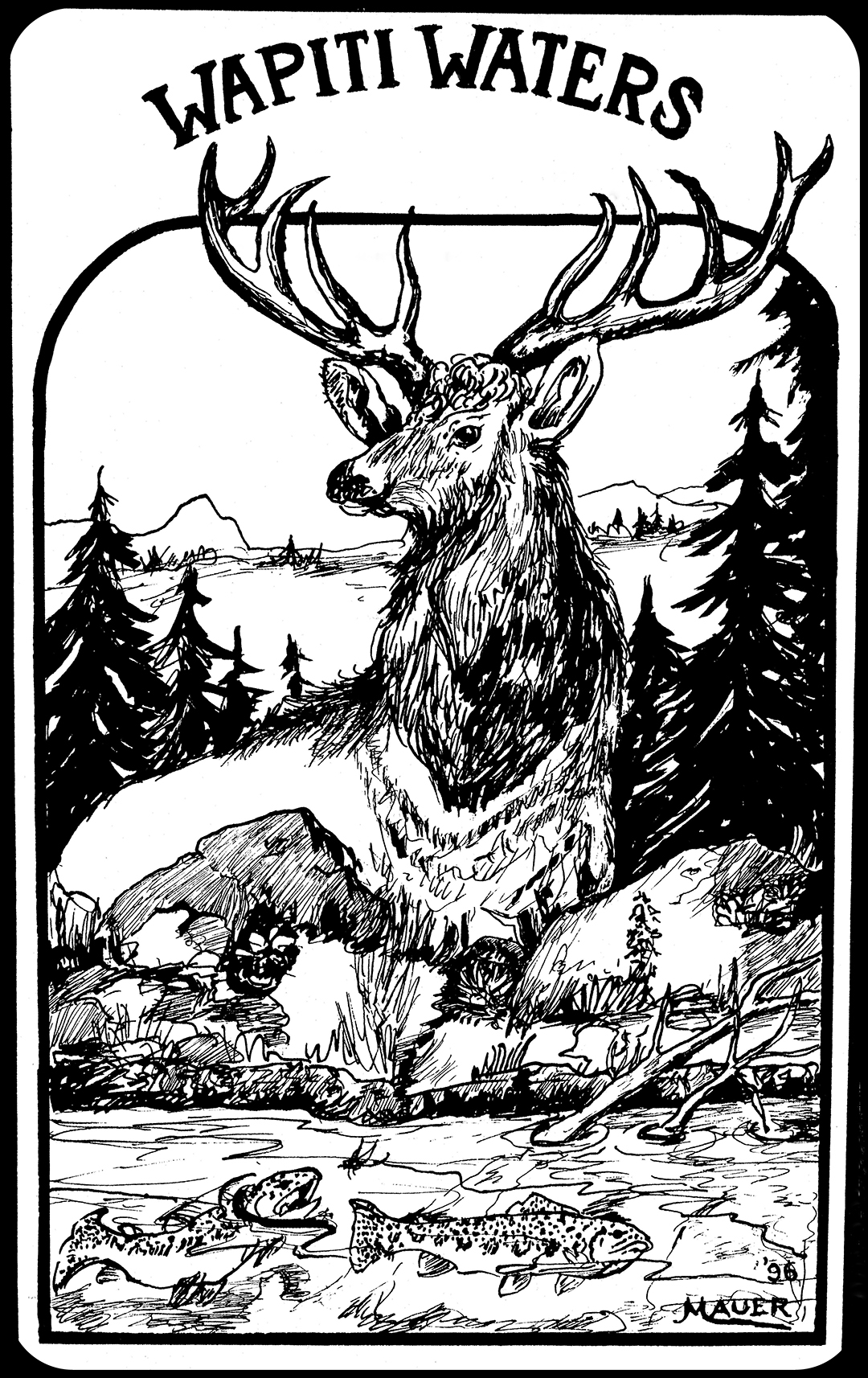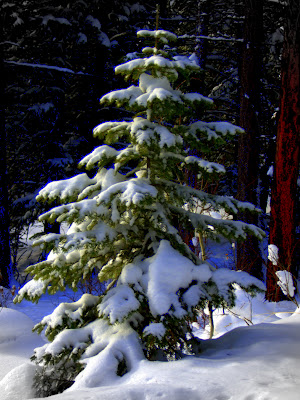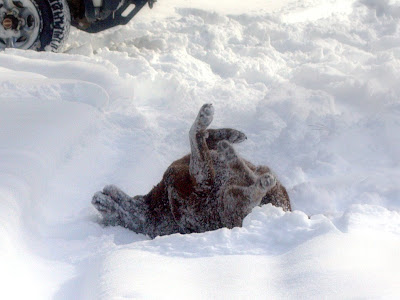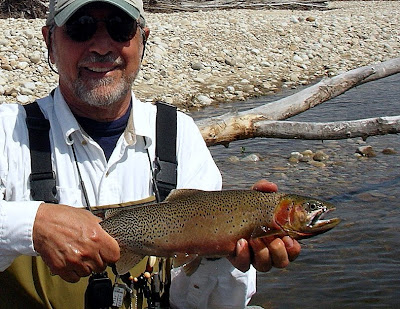
by Merle Ann Loman | Jan 5, 2009 | Friends

Thanks Joe and Betty for all the good times we have shared. We look forward to many more.
In the slideshow, you will see some of their passions…take a look. They know how to have fun all year-round! The fishing photos are ours, the rest are courtesy of Joe.
For full screen slideshow, click View Album, then choose “Slideshow.”

by Merle Ann Loman | Jan 3, 2009 | Friends

Friday I went to my friends retirement hoorah held at the the
Blacksmith Brewing Company. What a great surprise! It is in an old-time Stevensville Blacksmith Shop with it’s history and charm in tact – and the beer is fantastic! In honor of my friend’s retirement from a fire postion with the Forest Service, I had a Pulaski Porter for $3 a pint. The flavor was deep and rich; a smooth, dark taste. It seemed almost silky as I sipped it, yum.
Currently they have five choices –Brickhouse Blonde, Twisted Paddle Pale Ale, Burnt Fork Amber, Cutthroat IPA, and of course the Pulaski Porter. No seasonals are planned at this point.

We were there for the retirement party which meant us old codgers and our younger friends with children attended. No problem, in the non-smoking taproom there were other young families, singles, skiers, and plenty of locals. The old shop handles lots of people easily. They don’t serve food at this time, but many people were ordering from
Kodiak Jax which offers delivery.
Click here
for an article from NewWest.com about the brewery. It talks about the founders, brewmaster, the building and history, and more…good article!Blacksmith Brewing
Open Sun. – Fri. 3-8pm and Sat 12-8pm
114 Main St. Stevensville, MT * 406 777-0680
I am waiting for Tim Akimoff of the Missoulian and Grizzly Growler to do a story on this brewery. Tim….where are you? I assure you, this brewery is much more than a “rumor.” It is here to stay!
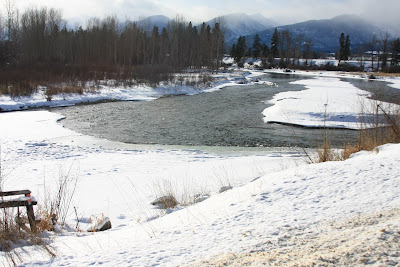
by Merle Ann Loman | Jan 3, 2009 | Bitterroot, iiii Winter/Snow

I am sharing photos of the Bitterroot valley, river and mountains in December. View the slide show or click on it to view the web album.
We had rain, then snow, then FREEZING COLD, then rain, more snow…a very unusual early winter. There is a lot of moisture, much beauty, and I need to mention the avalanche danger again. We will all be eager to get out to ski the backcountry. Please check the avalanche site for western Montana before you go. Be safe.
by Merle Ann Loman | Dec 30, 2008 | iiii Winter/Snow
I revisited a great site today. We have had new snow, now it is warming up. I wondered what information I could find about our Bitterroot snowpack. As I have said before, for fly fishing, snowpack is a huge indicator of what to expect in our upcoming season. We also want to recreate and be safe. See below and click on the hotlinks for more information.
Happy Holidays! This is Steve Karkanen at the West Central Montana Avalanche Center with the avalanche advisory for December 29th, 2008.
Please read the above link if you plan on skiing in western Montana. Danger is HIGH.
Remember the adage, be careful what you ask for? Well, we’re getting what we’ve been asking for. The problem is that it’s coming in a way that our current basal snowpack layers cannot support….
….The good news is that the new snow has been coming in gradually with a slow warm up. The weak layer near the rain crust is gaining strength over time and is adjusting quite well to each storm that slowly adds weight to it. The bad news is the cold temperatures we’ve experienced the past 2 weeks has allowed the weak granular sugary snow around the crust to persist so when we receive a storm that drops a lot of weight (several inches of snow or any amount of rain) it won’t be able to adjust fast enough to be safe. The really bad news is that the forecast is calling for a warm up with significant snowfall and wind perhaps even rain at some mountain locations this weekend.
To learn more, visit http://www.missoulaavalanche.org/events/ for classes and films showing in the Missoula area. BE SAFE!!!
Jack and I have been cross country skiing almost every day. Here is a slideshow from yesterday.
If you are going out for a back country ski, tell people where you are going and when you expect to be back. Visit this link for Weather Forecast and Avalanche Outlook in the Missoula and Bitterroot area.

by Merle Ann Loman | Dec 26, 2008 | music

Forever Bluegrass By JOE NICKELL – Like the seasons that govern the growth of all good things in nature, bluegrass music is forever dying away and resprouting anew. In the 1950s, the energetic sounds of Appalachia were spreading far and wide in American culture, until rock ’n’ roll appeared and diverted everyone’s attention
…read the rest of his story.
Excerpt:
The story of Pinegrass actually dates back to the late ’70s, when bluegrass bands such as Poor Monroe, the Great Northern Bluegrass Band (of which Ryan was a member), and Finley Creek frequented stages around western Montana. Over time, the members of those groups became the core of an increasingly tight-knit community of pickers and fans, who began gathering every Wednesday at a local instrument store called String Instrument Division or at the house of one of the musicians to play together in impromptu picking circles.
“Anybody could show up, and everybody got to play,” recalls Ryan fondly.
Like clockwork Pinegrass performs every Tuesday night at the Top Hat Lounge – click for map, located at 134 W. Front St. in Missoula. Through the end of this month, the band begins its performances at 10:30 p.m.; beginning on the first Tuesday of January, the band will begin its performances at 9 p.m. Admission is free.
Top Hat phone – (406) 728-9865
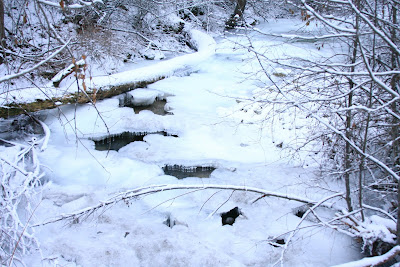
by Merle Ann Loman | Dec 23, 2008 | Conservation/benefits/organizations, iiii Winter/Snow
Click the photo for a larger view in a new window.

This is my attempt to provide a little more information about trout behavior (Part I); and ice development and anchor ice (Part II). In my research, I found only few studies, and I am pleased to reference for Part I a study that was done here in the Bitterroot.
I ran this article by Chris Clancy, our local Montana Fish, Wildlife and Parks fisheries biologist and one of the authors of the Bitterroot study. His input:
I think the take home message is that some sort of overhead cover and a variety of habitats are helpful to trout in the winter. Streams that are simplified by overgrazing or channelization lose the diversity of habitats. Deep pools are particularly important. I expect the winter movement is not really something they want to do but more likely they have to as the location they are in has changed or somehow become inadequate for their needs, so they find another. Generally in a healthy stream, the mortality during winter is much higher than summer.
Part I – Trout
Trout obviously prefer to expend as little energy as possible in the winter. In the study referenced in this section, bull trout and cutthroat trout made extensive downstream overwintering movements with declining temperature in the fall, yet for the remainder of the study (until late February), most fish remained stationary. Some fish made additional downstream movements in winter during a low-temperature period marked by anchor ice formation. Winter movement was more extensive in the mid elevation stream where frequent freezing and thawing led to variable surface ice cover and frequent supercooling. Habitat use of both species varied with availability; beaver ponds and pools with large woody debris were preferred in one stream, and pools with boulders were preferred in the other. Trout overwintered in beaver ponds in large, mixed aggregations. Both species decreased use of submerged cover following the formation of surface ice.
Their results indicate that (1) continued activity by trout during winter is common in streams with dynamic ice conditions and (2) complex mixes of habitat are needed to provide suitable fall and winter habitat for these species.
My note: It is my understanding the “complex mixes of habitat” produce more static ice conditions and are most often streams with natural vegetation and “undisturbed” i.e. not altered by man (mostly construction) or overgrazing. Open streams, where there is little or no cover and vegetation, produce more dynamic ice conditions. Other studies suggest that even though trout may be in streams with dynamic ice conditions, their preference is for more static or stable conditions – where thermal cover might help keep the surface ice from freezing and thawing.
References for Part I
THE ROLE OF STREAM ICE ON FALL AND WINTER MOVEMENTS AND HABITAT USE BY BULL TROUT AND CUTTHROAT TROUT IN MONTANA HEADWATER STREAMS, Jacober, M. J., McMahon, T. E., Thurow, R. F., Clancy, C. G., Abstract, Page 1 Click here for their paper published by the American Fisheries Society 1998
Part II – Ice
Traditionally, habitat variables have been related to stream flow distribution, structure, cover, temperature, and water quality. Winter and ice formation will influence these variables.
As winter approaches and temperatures lower, the water cools. As it reaches the freezing point, border ice begins to form along the river margins and around obstacles and skim or surface ice forms in low flow velocity areas.
In low gradient areas static ice formation occurs and surface ice is established. Due to increased resistance by the ice, water depth increases and velocities are reduced. In low gradient rivers and river reaches static ice formation occurs enabling stable conditions. Surface ice decreases the amount of light and creates cover against predation and severe hydraulic conditions allowing fish in these areas to preserve energy more efficiently.
Ice production in small, steep rivers is dominated by dynamic ice formation with potential melting and freezing throughout the entire winter. In high gradient sections, such as rapids and riffles, dynamic ice formation dominates. Dynamic ice formation starts when water temperature drops below zero degrees. Here, the water temperature becomes super cooled and tiny ice crystals form, known as frazil ice, or floating ice plates (ice that forms as small plates drifting in rapidly flowing water where it is too turbulent for pack ice to form). In locations with sufficient turbulence, frazil ice is transported towards the riverbed where it adheres and forms anchor ice. Normally, anchor ice formation develops during night and pauses during day.
Anchor ice formation can be extensive and may cover large areas. It may be distinguished between two types according to its formation process: Type I: less dense and forming on top of the substrata and Type II: Dense and forming between the substrata, filling all the small openings and spaces. During the events of anchor ice formation, flow conditions may be substantially altered. Type II anchor ice will potentially exclude important fish habitat. Fish may experience entrapment or be forced to relocate into other suitable areas, preferably surface ice covered stream margins.
In small, steep rivers, extensive growth of anchor ice may occur and lead to the formation of anchor ice dams. These anchor ice dams are normally developed in transition zones between riffle and pool sections and in locations with emergent, large boulders, and can slow further surface ice growth. High mortality of trout has been observed during the formation and breakup of anchor ice dams due to stranding, ice collapse, and physical abrasion from suspended ice particles.
References for Part II
ANCHOR ICE FORMATION AND HABITAT CHOICE OF ATLANTIC SALMON (SALMO SALAR L.)PARR IN STEEP STREAMS, Stickler, M. (M.Sc.), submitted to the Norwegian University of Science and Technology – Click here for the online paper
ICE IN THE ENVIRONMENT, Stickler, M., click here for the online paper

by Merle Ann Loman | Dec 22, 2008 | iiii Winter/Snow

Not only do we love a good snow pack in the mountains for next year’s fishing, we enjoy recreating in it. These photos are from a hike on December 20. We are off

for our first cross country ski this afternoon. It has been snowing for 24 hours and now that our office work is done for the day, we are heading out for that much anticipated ski!
Skiing was great! Temp was about 12 degrees C. and no wind. See the slideshow below.
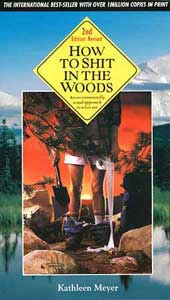
by Merle Ann Loman | Dec 21, 2008 | Friends

How to Shit in the Woods:
An Environmentally Sound
Approach to a Lost Art
“This is the most important environ-
mental book of the decade [1989].”
—W. David Laird, Books of the Southwest
“Kathleen Meyer has contributed to environmental awareness while lending a grand old English word the respectability that it hasn’t had since Chaucer’s day.”
—Frank Graham, Jr., Audubon magazine
“Hey, this is the real shit.”
—Galen Rowell, outdoor photographer and writer
“It’s something we all feel qualified to do, yet never talk about . . . For once, we get good tips on how to keep campsites clean while maintaining modesty and comfort.”
—Outside magazine
Visit www.kathleeninthewoods.com for more about the author and her books.
Kathleen Meyer and Patrick McCarron live in Victor, Montana. Kathleen is an author and has an editing business. Visit her site to find out more. If you need an editor, you will want to consider Kathleen.

by Merle Ann Loman | Dec 19, 2008 | hunting/fauna/flora, iii Fall

On I-15 between Salt Lake City, Utah and Butte, Montana there is a small town. Take the Lima exit and go to Dell, Montana. You will see a unique cafe, the Calf-A, in an old, brick schoolhouse with the menu on the blackboard. I hear from the locals that the population of Dell “depends on the time of day.”
Michael McCoy talks about the Calf-A in his travel guide, Montana – Off the Beaten Path – A Guide to Unique Places. He says,”The old building it is housed in was a school from 1903 until 1963, with an average enrollment of twenty kids, and then opened as a restaurant in 1978. Its walls, shelves, and bare pine floor are blanketed with memorabilia, fur-bearing trout, piles of old Life magazines, vintage rifles, an old piano with yellowed sheet music, rocks and fossils, a bedpan banjo, well-worn school desks, pull-down maps, spurs, kerosene lanterns, a ceramic water cooler, and a whole lot more.”
The photo is of Ted Lowe in front of the Calf-A. Jack and Ted were in the area for five days in mid-December hunting elk during the extended season. The wind was howling and the temperature hovered at 27 degrees below zero. They hunted, but had no success. The conditions were brutal for humans. The saw lots of elk, but just couldn’t get to them without freezing, sometimes they couldn’t even get the old Dodge started! When they did, they came home.
The Calf-A is also called Yesterday’s Cafe or Yesterday’s Calf-A. Click here
for the Travel Montana website and more information.
